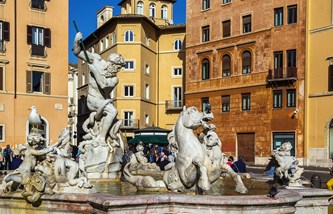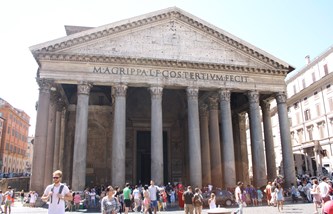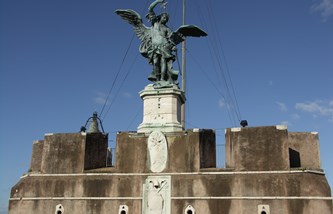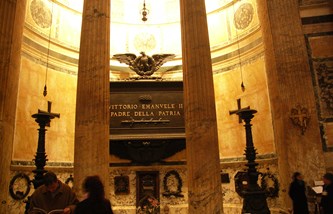Tours

Rome Tourist Card
Rome Tourist Card
Snap up the Rome Tourist Card and you'll get everything you need to explore Rome's top highlights including Colosseum, Palatine Hill, Roman Forum and Hop on/off bus. You can even choose the order you see things in.

Colosseum, Roman Forum & Palatine Hill: Priority Entrance
Colosseum, Roman Forum & Palatine Hill: Priority Entrance
Skip the long lines at the Colosseum with this priority-entrance ticket. This ticket will let you bypass the crowds. And after exploring the Colosseum you can head to the area of the Roman Forum and the Palatine Hill.
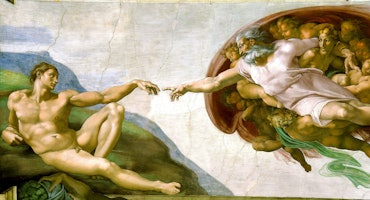
Vatican Museums & Sistine Chapel: Skip The Line
Vatican Museums & Sistine Chapel: Skip The Line
This ticket will make you save stress and time by allowing you to get priority entrance and skip the line. Visit the the countless masterpieces by Michelangelo, Raphael, Caravaggio, Tiziano and the Sistine chapel.
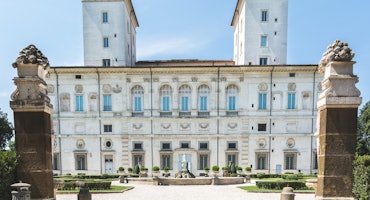
Borghese Gallery: Fast Track
Borghese Gallery: Fast Track
Galleria Borghese is located in the villa of the park Villa Borghese. Admire the architecture and furnishings of this beautiful villa. It is a museum full of art from the Renaissance. The collection includes several sculptures and paintings. Because of limited capacity get tickets for this museum weeks in advance.
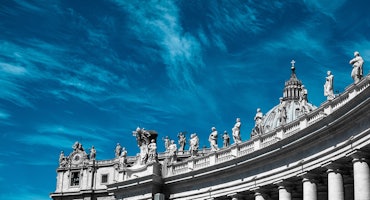
St. Peter’s Basilica: Dome Climb with Guide
St. Peter’s Basilica: Dome Climb with Guide
Get the most out of your visit to St. Peters with a guided tour to climb the basilica’s dome designed by Michelangelo and admire one of the stunning view. After the tour, you can explore the the basilica at your own pace.
Sant'Agnese in Agone
When you visit Piazza Navona, you’ll be totally surrounded by some of the best examples of Baroque architecture of the Capital. Among the stunning fountains and buildings, there is a church that definitely stands out, brightening up the square with its shiny marbles and intriguing facade. Inside, the church shows all the opulence that was the signature of some of the main architects and artists of the XVII century, such as Francesco Borromini. The church is a popular destination among pilgrims from all over the world, who come here to pay a visit to one of the most notable sacred relics belonging to the early Christian tradition.
A Baroque Jewel
In 1651, Pope Innocenzo X decided to build a new church on the site of martyrdom of Sant’ Agnese, whose story you’ll learn further down this article, and who is considered one of the most famous martyrs. The ancient church stood on land that was property of the family of the pope (the Pamphilj’s), and originally had to become a sort of private chapel for the pope and his kin.

The pope commissioned the task of erecting the church to the architect Girolamo Rainaldi, but, shortly after that, the works came under the direction of Francesco Borronimi, who was the greatest rival of Bernini. Borromini, who during the papacy of Innocenzo X had finally reached the status of influential architect, partially overshadowing Bernini’s fame, made some important changes to the original project, including the two bell towers and the peculiar shape of the facade. Then, when the building was still under construction, the pope died.
His successor, Alessandro VII, questioned some of the choices made by Borromini. The architect, who was a very troubled and insecure man, could not stand such an investigation on his design and left the project. Carlo Rainaldi, the son of Girolamo, took over the project and eventually finished it. By this time, Bernini had once again become the preferred architect of the Papal State, and Borromini saw some of his buildings created in the city, altered and changed against his will. After this and other professional delusions, Borromini fell into a deep depression, which led him to commit suicide, not before burning all his original drawings, afraid that someone could steal his original ideas.
Those two prominent artists were rivals all their lives. Today, we can still admire the results of their efforts to show their skills and artistic value in many attractions around the historical center. Here, in Piazza Navona, the daring overlays of geometrical shapes and the unique “cupped” facade of Borromini’s Church of Sant’Agnese stand in front of the splendid Bernini’s Fountain of the Rivers, with its famous statuary and high obelisk which almost defies gravity. The two artists are here, one in front of the other, looking at each other’s art, probably still wondering who deserves to be crowned best architect of Baroque Rome, and we can do nothing else but suspend judgment and just admire the timeless beauty of their legacy.
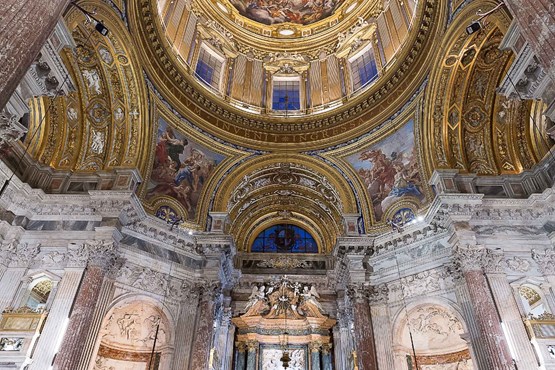
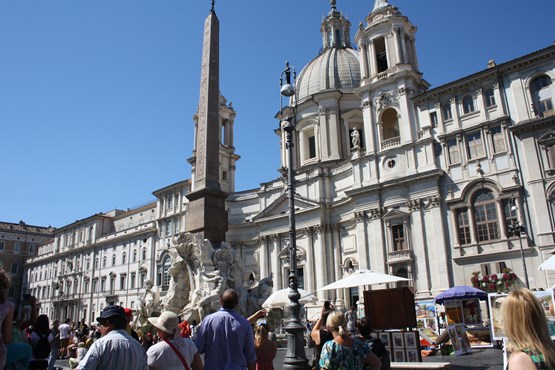
Inside the Church: The Chapels
Sant’Agnese has an unusual floor plan, as it’s fairly wide, but only approximately 40 meters deep. Inside, there are four different chapels. The first one is dedicated to Agnese, and it features a statue created by Ercole Ferretti, who based his design on one of Bernini’s drawings.
The second chapel is dedicated to San Filippo Neri, closely linked to the Pamphilj family, who included a pope (Innocenzo X) and a cardinal who were friends and devoted to the saint.
The third chapel was built to honor Santa Francesca Romana, who is one of the patron saints of the city. The family of Francesca lived nearby the church, and in this chapel you will find a painting depicting the saint together with an angel. The last, and fourth chapel features a statue of San Sebastiano, created by Pietro Paolo Campi between 1717 and 1719.
One of the most interesting features of the church are the two pipe organs. The main one was made in 1913, and it replaced the one created by the Fleming artist Guglielmo Hermans in 1673. The new organ contains the original pipes of the older one. The other instrument is a positive organ, dating back to 1850 and recently completely restored.

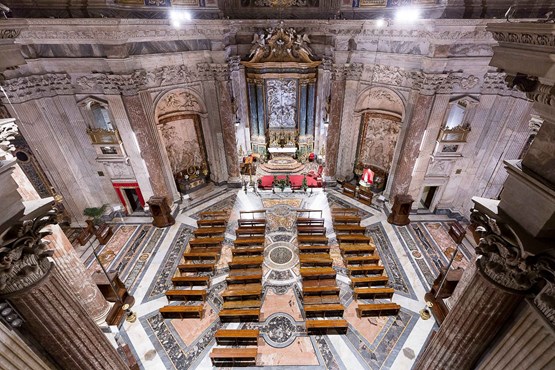
The Crypt of Sant’Agnese
Most of the visitors entering the church head directly to the left side of the building, next to the altar, where a staircase (designed by Borromini) leads down to the crypt of Sant’Agnese. The site of the crypt is believed to be in the exact spot where the young woman was killed. Here, enclosed in a reliquary, is Agnese’s skull, one of the most treasured relics belonging to the history of early Christianity.
The crypt of Sant’Agnese is the only thing that remains of the ancient church of Sant’Agnese in Agone, and was originally built converting some of the rooms that were part of the Emperor Domitian circus. It was completely restored by Borromini in 1653. There have been several floods afterwards that have caused damage to the frescoes on the walls and the floor. For this reason the crypt underwent important restoration works in 1885. Then, again, the crypt has been restored in recent years, because there was still frequent rain leaking from the upper square.
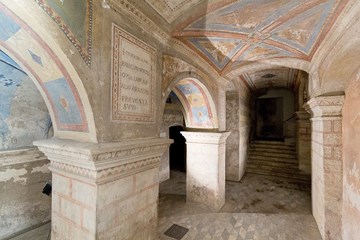
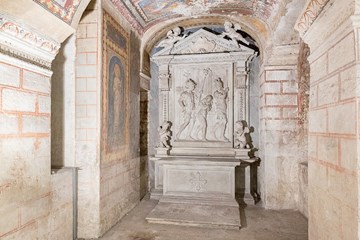
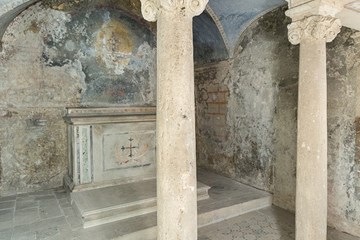
In Memory of a Young Martyr
As you have probably started to discover, if you have read other pages of our website, almost every corner of this city, every building, fountain and landmark stands as a memoir of a past event. A “city plan” was something that was almost never considered for the whole of the center of Rome, and, I must add, luckily, as this is exactly what it gives Rome its irresistible and unpredictable charm.
The reason behind the building of the church is linked to events that happened during the reign of Emperor Domitian, in the year 305 AD, less than ten years before the conversion of the Emperor Constantine, which in fact made Christianity the official religion of the Empire. Back then, the Piazza Navona square was an arena for chariot races and shows (similar to the Circus Maximus). Agnese was a young noblewoman who refused, according to accounts hovering between actual history and myth, to marry the son of the Prefect of Rome, who had set his eyes on her. Agnese was a fervent Christian, and she had devoted her life to prayer, and soon took vows of chastity.
Her decision was considered an intolerable affront, and she was forced to become a vestal virgin. When she refused to serve a pagan deity, she was then punished and sent to work in a brothel, but, because no man dared touch her, she was accused of sorcery, and sentenced to be burned at the stake. According to the hagiographical tradition, even the flames refused to do her any harm, so she had to be killed by a sword. When she died, she was only twelve years old.
Concerts and Events
Today, the church hosts regular baroque and chamber music concerts, mainly on the weekends. The concerts take place in the charming setting of Borromini’s sacristy, which is a hall accessible directly from the church, and has been restored and opened to the public in the year 2000.
FAQ
Where is Sant'Agnese in Agone?
Sant'Agnese in Agone a Baroque church in Piazza Navona, Rome
Why is Sant'Agnese in Agone famous?
The church of Sant'Agnese in Agone is famous because here you can visit the crypt and the relics of St. Agnese, a young Christian martyr.
What can I see in Sant'Agnese?
Sant'Agnese is a Baroque church, and was designed by Borromini, a famous architect in Rome. You can visit the four chapels of the church and the crypt.
Who is Francesco Borromini?
Francesco Borromini was an architect who designed many churches and buildings in Rome. Together with Gian Lorenzo Bernini, is one of the greatest exponents of Baroque art.
Is the church of Sant'Agnese in Agone free to enter?
Yes, the church of Sant'Agnese in Agone is free to enter.
